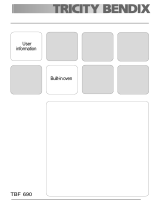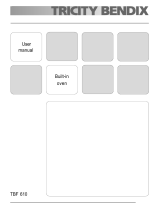
This system makes it possible to cook in a steamy en-
vironment and keep the dishes soft inside and crusty
outside. Moreover, the cooking time and energy con-
sumption are reduced to a minimum. During cooking
steam may be produced which can be released when
opening the oven door. This is absolutely normal.
Warning! However, always stand back from the
oven when opening the oven door during cooking
or at the end of it to allow any build up of steam or heat
to release.
Warning! Do not place objects on the oven base
and do not cover any part of the oven with
aluminium foil while cooking, as this could cause a heat
build-up which would affect the baking results and
damage the oven enamel. Always place pans, heat-
resisting pans and aluminium trays on the shelf which
has been inserted in the shelf runners. When food is
heated, steam is created, like in a kettle. When the
steam comes into contact with the glass in the oven
door, it condenses and creates water droplets.
To reduce condensation, always preheat the empty
oven for 10 minutes.
We recommend you wipe the water droplets away after
every cooking process.
Warning! Always cook with the oven door
closed, even when grilling. Stand clear when
opening the drop down oven door. Do not allow it to
fall open - support the door using the door handle, until
it is fully open.
Fan Cooking
The air inside the oven is heated by the element around
the fan situated behind the back panel. The fan circu-
lates hot air to maintain an even temperature inside the
oven.
The advantage of cooking with this function is en-
ergy saving through:
• Faster Preheating
As the fan oven quickly reaches temperature, it is
not usually necessary to preheat the oven although
you may find that you need to allow an extra 5-7
minutes on cooking times. For recipes which require
higher temperatures, best results are achieved if the
oven is preheated first, e.g. bread, pastries, scones,
souffles, etc.
•
Lower Temperatures
Fan oven cooking generally requires lower temper-
atures than conventional cooking. Follow the tem-
peratures recommended in the cooking chart. Re-
member to reduce temperatures by about 20-25°C
for your own recipes which use conventional cook-
ing.
• Even Heating for Baking
The fan oven has uniform heating on all shelf posi-
tions. This means that batches of the same food can
be cooked in the oven at the same time. However,
the top shelf may brown slightly quicker than the
lower one. This is quite usual. There is no mixing of
flavours between dishes.
– Shelf positions are not critical, but make sure the
shelves are evenly spaced.
– When cooking more than one dish in the fan oven,
place dishes centrally on the shelves rather than
several dishes on one shelf.
– When the oven is full, you may need to allow slightly
longer cooking time.
– When the oven is full of the same food, e.g. equal
trays of small cakes or equal size victoria sandwich
cakes, then they will be cooked in the same time and
removed from the oven together. When different
sizes of trays or types of food, e.g. biscuits and cakes
are cooked, they will not necessarily be ready to-
gether.
– The fan oven can be used to heat foods through
without thawing first, e.g. fruit tarts, mince pies,
sausage rolls, and other small pastry items. Use a
temperature of 190-200°C and allow 20-40 minutes
(depending on the quantity of food in the oven).
– The use of too high temperatures can cause uneven
browning. Check with the recommendations for
oven temperatures given in the cooking charts, but
be prepared to adjust the temperature, if necessary.
Remember to reduce temperatures by about
20-25°C for your own conventional recipes.
– When roasting do use the trivet in the meat tin. Fat
and meat juices will drain into the meat tin below and
can be used to make gravy. The trivet also prevents
splashes of fat from soiling the oven interior.
– The meat tin should not be placed on a heated hot-
plate as this may cause the enamel to crack.
How to use the Fan Oven
1.
Turn the oven function control knob to
.
9





















